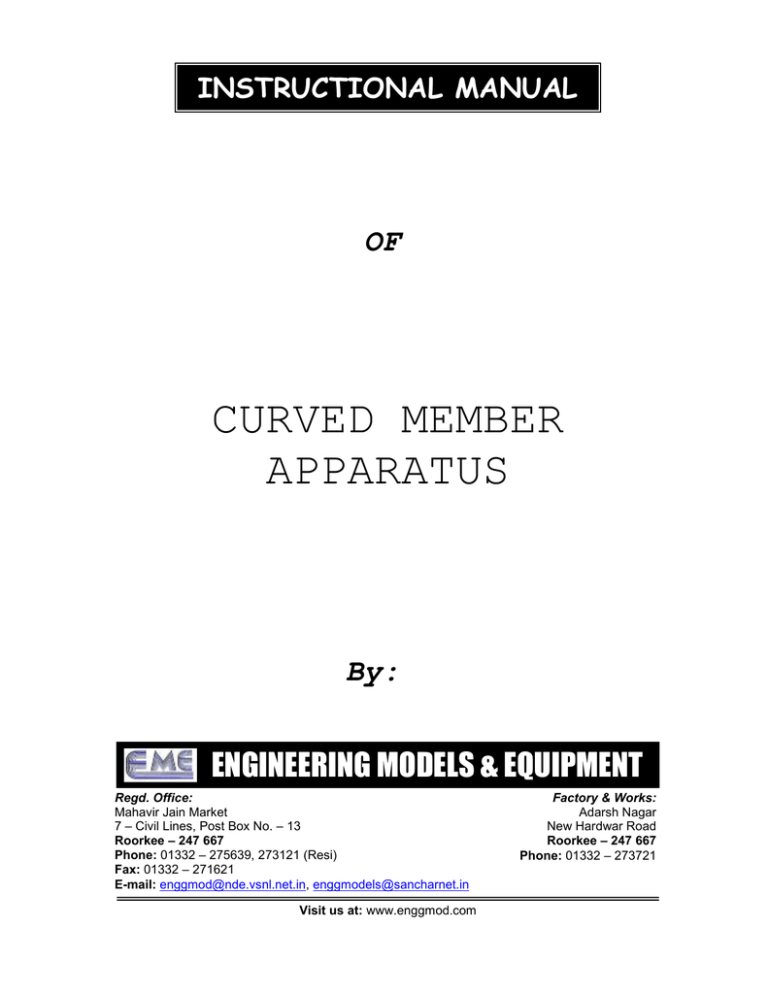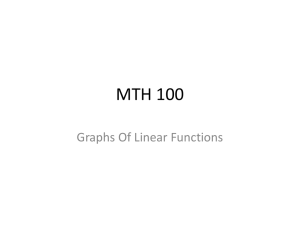Curved Member Apparatus
advertisement

INSTRUCTIONAL MANUAL OF CURVED MEMBER APPARATUS By: ENGINEERING MODELS & EQUIPMENT Regd. Office: Mahavir Jain Market 7 – Civil Lines, Post Box No. – 13 Roorkee – 247 667 Phone: 01332 – 275639, 273121 (Resi) Fax: 01332 – 271621 E-mail: enggmod@nde.vsnl.net.in, enggmodels@sancharnet.in Visit us at: www.enggmod.com Factory & Works: Adarsh Nagar New Hardwar Road Roorkee – 247 667 Phone: 01332 – 273721 2 CURVED MEMBER APPARATUS CONTENTS: Page No. 1.0 Theory 03 2.0 Objective 05 3.0 Apparatus 05 4.0 Suggested experimental work 05 5.0 Results & Discussions 05 6.0 Sample Data Sheet 06 7.0 Comments 07 8.0 Precautions 07 3 CURVED MEMBER APPARATUS 1.0 THEORY: Castigliano's first theorem is used to find the elastic displacements of curved members. Theorem states" Partial derivative of the total strain energy of a structure with respect to any force gives the displacement of the point of its application in the direction of the force". The total strain energy of any structure is determined in terms of all the load with their actual values and a fictitious load P applied at the point at which the deflection is required and it is acting in the same direction in which the deflection is required. In case no external load is acting at the joint in the direction desired, a fictitious load is applied in that direction and forces in all members are worked out. After partial differentiation with respect to P, zero is substituted for fictious load P (or if P is not fictitious its actual value is substituted). Thus the result is the required deflection. In all cases the horizontal BH and vertical deflection BV due to vertical load W are to be determined. These deflections are obtained by using Castigliano's first theorem where strain energy due to bending only is taken into account. The results obtained for the four curved members shall be as follows: (a) Quadrant of a circle Fixed at A and free at B (radius R) and subjected to a concentrated load W at free end. B W R A (a) Vertical displacement of load point = BV WR 3 4 EI WR 3 Horizontal displacement of load point B = BH 2 EI 4 (b) Quadrant with a straight leg From A to B, quadrant of a circle of radius R, from B to C straight length of y. A W R B y C (b) Vertical displacement of load point A = AV = WR 3 4 EI Horizontal displacement of load point A == AH = (c) WR 2 y EI WR ( R y) 2 2 EI Semicircle with straight arm From A to C semi circle of radius R, A to B straight length of y W A B y R C (C) Vertical displacement of loaded point B = BV = W 2 y 3 3R (2y 2 8 y R R 2 ) 6 EI WR 2 (y 2 R) Horizontal displacement of loaded point B == BH = EI 5 (d) Circle of radius R W B X R X (D) Vertical displacement of loaded point B = BV 2.0 WR 3 ( 2 8) 4EI OBJECTIVE: To determine the elastic displacement of the curved members experimentally and verification of the same by analytical methods. 3.0 APPARATUS: Apparatus consists of a steel bar which, is used to make the different curved members Viz. Circle, semicircle with straight arm, a quadrant of a circle and quadrant of a circle with straight arm. The bottom ends of the members are fixed to the base. Under the application of load at free end, its horizontal and vertical deflection is measured with the help of a dial gauge. 4.0 SUGGESTED EXPERIMENAL WORK: Step1: Place a load on the hanger to activate the member and treat this as the initial position for measuring deflections. Step2: Fix the dial gauges for measuring horizontal and vertical deflections. Step3: Place the additional loads at the steps mentioned in the table below for each case and tabulate the values of dial gauge reading against the applied loads. 5.0 1. RESULTS AND DISCUSSIONS: Plot the graph load Vs deflection for each case to show that the structure remains within the elastic limit. 6 2. 6.0 Measure the value of R and straight length in each case. Find width and depth of steel section and calculate the value of I as bd3/12 SAMPLE DATA SHEET: Name of the experiment: Deflection of Curved Member apparatus Name of student: Semester Width of section (mm) b Depth of section (mm) d = = Least moment of inertia = Batch Session bd 3 12 = 2 x 106 E (kg/cm2) (a) Quadrant of a circle Sl. No. Additional load (kg) Dial gauge reading (mm) Deflection (mm) Horizontal direction Horizontal direction (b) Quadrant with Straight leg Sl. No. Additional load (kg) Vertical direction Dial gauge reading (mm) Horizontal direction (c) Semi-circle with straight leg Sl. No. Additional load (kg) Vertical direction Dial gauge reading (mm) Horizontal direction Vertical direction Vertical direction Deflection (mm) Horizontal direction Vertical direction Deflection (mm) Horizontal direction Vertical direction 7 (d) Circle Sl. No. Additional load (kg) Dial gauge reading (mm) Horizontal direction Vertical direction 7.0 COMMENTS: 8.0 PRECAUTIONS: Apply the loads gently. Measure the displacements very accurately. Deflection (mm) Horizontal direction Vertical direction




